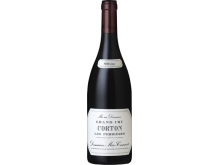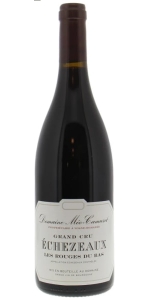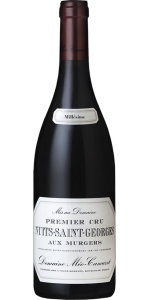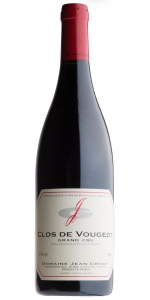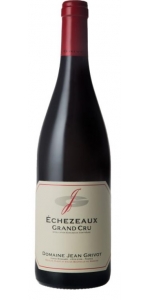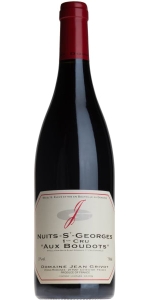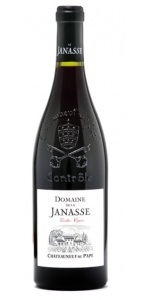Domaine Meo-Camuzet Corton Les Perrieres Grand Cru 2020
6 bottles with free shipping for: $2,550.00
| BUY MORE! SAVE MORE! | ||||||||||||||||
|
| Country: | France |
| Region: | Burgundy |
| Winery: | Meo-Camuzet |
| Grape Type: | Pinot Noir |
| Organic: | Yes |
| Vintage: | 2020 |
| Bottle Size: | 750 ml |
Domaine Meo-Camuzet Corton Les Perrieres Grand Cru 2020
Your first impression of Les Perrieres is that of a typical Corton, as it is so frequently described: austere, slow to mature, tannic. But that impression should be moderated because the wine is apparently multifaceted: frankness, certainly, but also an underlying structure that lines the palate and a finish marked by minerality. There's no heaviness, which facilitates the expression of this complexity. A long ageing period is certainly beneficial.
Review:
One of the highlights of the range this year is the 2020 Corton Grand Cru Les Perrières, a vibrant, mineral wine evocative of wild berries, forest floor, rich spices and rose petals. Medium to full-bodied, concentrated and vibrant, with beautifully refined tannins and a long, penetrating finish, it's well worth seeking out.
Robert Parker's Wine Advocate 93-95+ Points
For more than four centuries, the members of the Méo family have devoted themselves to growing vines and making wines. They came originally from the Burgundy village of Selongey, in the north of Côte d'Or, where today, even if the vines, alas, have disappeared, a pressing house, dating from the year 50 AD, bears witness to the presence there of Gallo-Roman winegrowers.
From the 19th century onwards, the Méo children chose the course of study. The great-grandfather of Jean-Nicolas, for example, was a primary-school teacher, his grandfather graduated from the École Nationale des Ponts et Chaussées (civil engineering) and his father, Jean Méo, was a graduate of the École Polytechnique and an engineer in the Corps des Mines. Jean was later to be elected a Member of the European Parliament and sat on the Council of Paris.
It was thanks to Jean Méo's mother, Marcelle Lamarche-Confuron, originating from an old winegrowing family in Vosne (with already a small activity as négociants), that the Méos came to settle in Vosne-Romanée.
Jean Méo's grandmother was the first cousin of Étienne Camuzet, a very colourful character.
Étienne Camuzet (1867-1946) was a winegrower in Vosne-Romanée, mayor of the village and also an MP for Côte d'Or from 1903 to 1932. In 1920, he had the opportunity to purchase the Château du Clos de Vougeot with some of the vines, but instead of living there, he preferred to lodge his tenant farmers in it (indeed, because of his political activities, he no longer had time, himself, to look after his own vineyards). He was to sell it in November 1944: not surprisingly, the château had suffered during the war. He had (already!) understood the importance for Burgundy to have a "temple” to help promote its wine. Étienne Camuzet thus chose to pass it on to the Confrérie des Chevaliers du Tastevin.
As for the vines, it was the 20 hectares (50 acres) at the top of the Clos that were for sale ... Étienne Camuzet enlisted the help of his fellow winegrowers from Vosne-Romanée to acquire them. He would keep 3 hectares (7.5 acres) himself, immediately below the château.
Following the death of Étienne Camuzet, his daughter, Maria Noirot, inherited the estate from her father and retained the tenant farmers. She had no children, however, and when she died, in 1959, she bequeathed the estate to her nephew, Jean Méo, who at that time had already left Vosne-Romanée, and since 1958 had been a member of General de Gaulle's cabinet. Having been regularly in close contact with his uncle, who had shared with him his passion for the vine, teaching him to respect and love wine, the youngest of the Méos could not allow the winegrowing saga of the family to come to an end. He decided, therefore, to take the estate in hand, with help from his father, Gaston, initially, and then from his mother. In that way, Jean Méo was able to remain with General de Gaulle and to pursue his career in Paris, which would lead him to manage in succession several large companies: ELF, France Soir, Agence Havas, Institut Français du Pétrole and others. He was also elected to the European Parliament and sat on the Council of Paris. Throughout that period, he relied on four tenant farmers, including the great winegrower, Henri Jayer, who was one of the first to control temperatures systematically during vinification, always bringing out the freshness and the fruit, thus making the nose and the texture of the wine more attractive. Jean Méo was to manage the estate from 1959 to1984, after which he called upon the new generation.
In 1981, the Camuzet estate became Méo-Camuzet, and the first wines bottled under that name were those of the 1983 vintage.
Échezeaux is loyal to its appellation through the finesse of its attack on the palate and its overall balance. But it's also a wine with pronounced acidity, which gives it freshness and structure and bestows upon it a sometimes austere finish.
A clearly pronounced personality: powerful, sometimes wild aromas; a marked acidity, which give it a captivating freshness; a fine roundness, sometimes even opulence. In short, an intense wine which has many cards in its hand to win you over.
Review:
Notes of cherries, cassis, peonies and rich spices preface the 2020 Nuits-Saint-Georges 1er Cru Aux Murgers, a medium to full-bodied, velvety and concentrated wine that's lively and penetrating. Like its 2019 predecessor, it's especially seamless and charming.
-Robert Parker's Wine Advocate 92-94 Points
Domaine Jean Grivot Clos de Vougeot Grand Cru is made from 100 percent Pinot Noir.
Domaine Jean Grivot is among the great names in Burgundian wine. Étienne Grivot and his wife Marielle took over from Étienne’s father Jean Grivot in 1987. The vineyards are densely planted and farmed organically “sans certification” while the aim in the cellar is for balance and clear expression of terroir.
Jean Grivot’s 38.3 acres spread across 22 appellations with vineyards in the communes of Vosne-Romanée, Vougeot, Chambolle-Musigny, and Nuits-Saint-Georges. Besides the three grand crus, there are 8 premier crus including the much lauded Les Beaux Monts and Suchots in Vosne-Romanée. The grapes are completely de-stemmed and fermentation is spontaneous.
About the Vineyard:
Clos de Vougeot grand cru was acquired by Étienne’s grandfather, Gaston Grivot, in 1919. The total holding is 4.6 acres from the middle of the vineyard to the lower wall and the average vine age is 40 years old. A good Clos de Vougeot should be a complete wine without any one feature standing out. It is a perfect balance of power, aroma, and flavor.
Wine Production:
The grapes are destemmed and maceration à froid usually lasts just a day or two. The alcoholic fermentation is spontaneous and malolactic fermentation occurs in barrel. Depending on the vintage, the proportion of new oak is around 40-70% percent for the grands crus.
Tasting Notes:
The wine shows aromas and flavors of red berries, herbs, and purple flowers. The palate is rich with ripe fruit and medium weight with bright acidity and fine tannins. Aging in 40-70% new Burgundian pièce brings notes of vanilla, toast, and baking spices.
Food Pairing:
Red Burgundy might be the world’s most flexible food wine. The wine’s high acidity, medium body, medium alcohol, and low tannins make it very food-friendly. Red Burgundy, with its earthy and sometimes gamey character, is a classic partner to roasted game birds, grilled duck breast, and dishes that feature mushrooms, black truffles, or are rich in umami.
Review:
This round version is packed with ripe black cherry, violet, graphite and tobacco flavors. The silky texture and vibrant acidity work in tandem, while refined tannins provide support without getting in the way. There are a few edges to be worked out, yet this is long and concentrated.
-Wine Spectator 95 Points
Domaine Jean Grivot Echezeaux Grand Cru is made from 100 percent Pinot Noir.
Domaine Jean Grivot is among the great names in Burgundian wine. Étienne Grivot and his wife Marielle took over from Étienne’s father Jean Grivot in 1987. The vineyards are densely planted and farmed organically “sans certification” while the aim in the cellar is for balance and clear expression of terroir.
Jean Grivot’s 15.5 hectares spread across 22 appellations with vineyards in the communes of Vosne-Romanée, Vougeot, Chambolle-Musigny, and Nuits-Saint-Georges. Besides the three grand crus, there are 8 premier crus including the much lauded Les Beaux Monts and Suchots in Vosne-Romanée. The grapes are completely de-stemmed and fermentation is spontaneous.
About the Vineyard:
Echézeaux grand cru is a large vineyard of 38 hectares divided into 11 individual climats. Grivot’s parcel is in the climat of Les Cruots and lies at the southern end of Echézeaux near the premier cru of Les Suchots. A good Echézeaux should have rich fruit, considerable earthiness, and be very complete on the palate.
Tasting Notes:
The wine shows aromas and flavors of red berries, herbs, and purple flowers. The palate is rich with ripe fruit and medium weight with bright acidity and fine tannins. Aging in 40-70% new Burgundian pièce brings notes of vanilla, toast, and baking spices.
Food Pairing:
Red Burgundy might be the world’s most flexible food wine. The wine’s high acidity, medium body, medium alcohol, and low tannins make it very food-friendly. Red Burgundy, with its earthy and sometimes gamey character, is a classic partner to roasted game birds, grilled duck breast, and dishes that feature mushrooms, black truffles, or are rich in umami.
Review:
A very elegant expression of Echezeaux, with a velvety black plum and rose petal fruit. There is a lovely freshness and so much finesse that the tannin and structure might surprise you at the end. This has the substance to age for decades. Produced from a 0.84ha parcel in Cruots next to Comte Liger-Belair. The vines were planted in 1954 and the destemmed fruit was gently fermented.
This is pure, racy and enticing, hosting aromas and flavors of black currant, blackberry, violet and iron. This is about finesse, grace and precision balance, with saturated fruit flavors persisting on the superlong aftertaste. Needs a decade in the cellar.
-Wine Spectator 97 Points
Domaine Jean Grivot Nuits-Saint-Georges Premier Cru Aux Boudots is made from 100 percent Pinot Noir.
Domaine Jean Grivot is among the great names in Burgundian wine. Étienne Grivot and his wife Marielle took over from Étienne’s father Jean Grivot in 1987. The vineyards are densely planted and farmed organically “sans certification” while the aim in the cellar is for balance and clear expression of terroir.
Jean Grivot’s 38.3 acres spread across 22 appellations with vineyards in the communes of Vosne-Romanée, Vougeot, Chambolle-Musigny, and Nuits-Saint-Georges. Besides the three grand crus, there are 8 premier crus including the much lauded Les Beaux Monts and Suchots in Vosne-Romanée. The grapes are completely de-stemmed and fermentation is spontaneous.
Nuits-Saint-Georges Aux Boudots 1er cru lies in the “Zone Vosnoise” or northern end of Nuits-Saint-Georges just below Les Damodes. It borders Vosne-Romanée Aux Malconsorts 1er just to its north. Its position slightly lower on the slope with deep soil full of pebbles results in a richer and fuller wine.
The grapes are destemmed and maceration à froid usually lasts just a day or two. The alcoholic fermentation is spontaneous and malolactic fermentation occurs in barrel. Depending on the vintage, the proportion of new oak is around 30-60% for the premier crus.
The wine shows aromas and flavors of red berries, herbs, and purple flowers. The palate is rich with ripe fruit and medium weight with bright acidity and fine tannins. Aging in 30-60% new Burgundian pièce brings notes of vanilla, toast, and baking spices.
Red Burgundy might be the world’s most flexible food wine. The wine’s high acidity, medium body, medium alcohol, and low tannins make it very food-friendly. Red Burgundy, with its earthy and sometimes gamey character, is a classic partner to roasted game birds, grilled duck breast, and dishes that feature mushrooms, black truffles, or are rich in umami.
Reviews:
‘The 2020 Nuits Saint-Georges Aux Boudots Ter Cru has the best aromatics among Grivat Nuits Saint-Georges with very well defined red berry fruit, briary and lignt sous-bois aromas. The palate is medium-badied with fine-grain tannins, slightly savory on the entry, fresh and saline on the finish. This has real verve and class, though it will benefit from time in bottle
-Vinous 93-95 Points
A wine with the substance and structure to support the generous lashings of new oak used for maturation, and the overall effect is elegant and classic in style. Aux Boudots, where Grivot has 0.85ha, is at the northern edge of Nuits, just over the border from Vosne-Romanée Malconsorts. They began to pick on the 3rd of September – Etienne specified that they are very particular that the tannins are ripe and do what they can to prolong the vegetative cycle. Still, the grapes were picked with an entirely correct pH of around 3.4.
-Decanter 94 Points
Domaine de la Janasse Chateauneuf-du-Pape Cuvee Vieilles Vignes is made from 65% Grenache, 20% Mourvèdre, 10% Syrah, 5% divers.
In contrast to Chaupin, which is made from old-vine Grenache on sandy soils, the cuvée Vieilles Vignes is from old vines of Grenache, Mourvedre, Syrah along with smaller percentages of other permitted varieties that are grown in these old vineyards. The wine is sourced from 4 terroirs: pebbly clay, sand, gravelly red clay and sandy limestone. Vieilles Vignes is always the most powerful and concentrated Châteauneuf-du-Pape cuvée made at Domaine de la Janasse.
Review:
The 2020 Châteauneuf Du Pape Vieilles Vignes also saw some stems (the estate started keeping some stems with the 2016 vintage) and was 75% destemmed, with the blend being 70% Grenache, 20% Mourvèdre, and the rest Syrah, Cinsault, and Terret Noir. As usual, it’s a more powerful, black-fruited wine comparted to the Cuvée Chaupin and has lots of crème de cassis, liquid violet, crushed stone, woodsmoke, and peppery herbs. It displays the vintage’s purity and freshness yet brings the concentration as well as the structure. I’ll be shocked if it’s not in the handful of top wines in the vintage.
-Jeb Dunnuck 96-98 Points
- back
Tasting notes: A brand new wine from this tremendous vineyard, The Sokol Blosser Kalita Vineyard 2021 Estate Pinot Noir bursts with classic Yamhill-Carlton dark-fruit notes, including black cherry, cranberry, and blackberry. Warm spices, espresso, and woodsy forest floor are backed up with grippy tannins to balance the fruit.
Opus One is made from 78% cabernet sauvignon, 8% merlot, 7% petit verdot, 6% cabernet franc and 1% malbec .
The Opus One is remarkably elegant and bright offering sumptuous aromas of fresh red and blue fruit, baking spices and vanilla, and a delicate fragrance of spring florals. The initial bouquet is augmented by more nuanced notes of sage, rosemary, and black olive. Juicy flavors of black cherry, blackberry and cassis flood the palate and creamy, fine-grained tannins deliver a delightfully round structure. Harmonious and lively, the flavors linger to create an enduring finish with touches of dark chocolate and espresso.
Of the great European wine families, the Rothschilds are perhaps the best known. And Baron Philippe de Rothschild is perhaps the best known of this great family. At the age of 20, Baron Philippe took on the management of Château Mouton Rothschild from his father Baron Henri. Philippe’s vision changed the world of wine: he invented Château bottling, commissioned great artists to illustrate his wine labels – and, in partnership with Robert Mondavi in 1979, created Opus One.In the 1980s, after her father’s death, Baroness Philippine de Rothschild left a stage career that included the Comédie Française and the Renault-Barrault Theatre Company, bringing her own exquisite style and creativity to the design, construction, and operation of Opus One.Among great New World wine pioneers, Robert Mondavi is an international icon. Bringing a passion for excellence to everything he did, Robert Mondavi led a renaissance in California fine wine for over six decades. Among other accomplishments, he introduced temperature-controlled fermentation, French oak barrel aging, and high-density viticulture to a fledgling American wine industry. But life was not only wine for Robert Mondavi: he broadened the American cultural palate by marrying fine wine to food, music, and the arts. One of few Americans to have received the French medal of the Legion of Honor, Robert Mondavi showed extraordinary vision as co-founder of Opus One.
Review:
The purity of fruit is really something else here, with currants and fresh flowers, such as violets and roses. Flower stems as well. Fantastic length and structure to the wine, with tightness and focus. Wonderful fruit. Graceful. A blend of 78% cabernet sauvignon, 8% merlot, 7% petit verdot, 6% cabernet franc and 1% malbec. Try after 2028.
-James Suckling 99 Points

